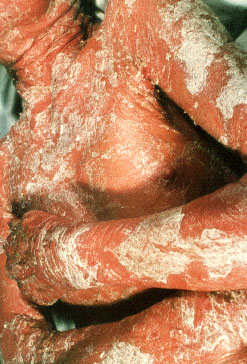|
|
|
Erythroderma
(e-rith"ro-der'mah) (Greek. Erythro - red, derma - skin)
A generalized redness of the skin. It is often associated with desquamation, as in exfoliate dermatitis.
Erythroderma, as the name implies, is a diffuse cutaneous eruption consisting of erythema, scaling and, usually, dermal edema.
There are many causes of cutaneous erythroderma. Causes include psoriasis, pityriasis rubra pilaris, ichthyosiform erythroderma, cutaneous drug eruption, diffuse atopic or allergic contact dermatitis, T-cell lymphoma (SÚzary) variant and T-cell leukemia.
Other skin diseases include diffuse dermatophytosis and even Norwegian scabies.
Treatment:
- Identifying the underlying disease process is imperative.
- Patients with erythroderma have great difficulty regulating body temperature and care should be maintained not to become hypothermic.
- These patients are prone to bacterial skin overgrowth with the possibility of systemic septicemia. Emollients and mild glucocorticoids such as 1% hydrocortisone applied liberally to the affected areas are usually helpful in the absence of a definitive etiology.
- Hospitalization may be required for adequate management.

Back to Dermatology Glossary - E Index |
Back to Dermatology Glossary Index
|